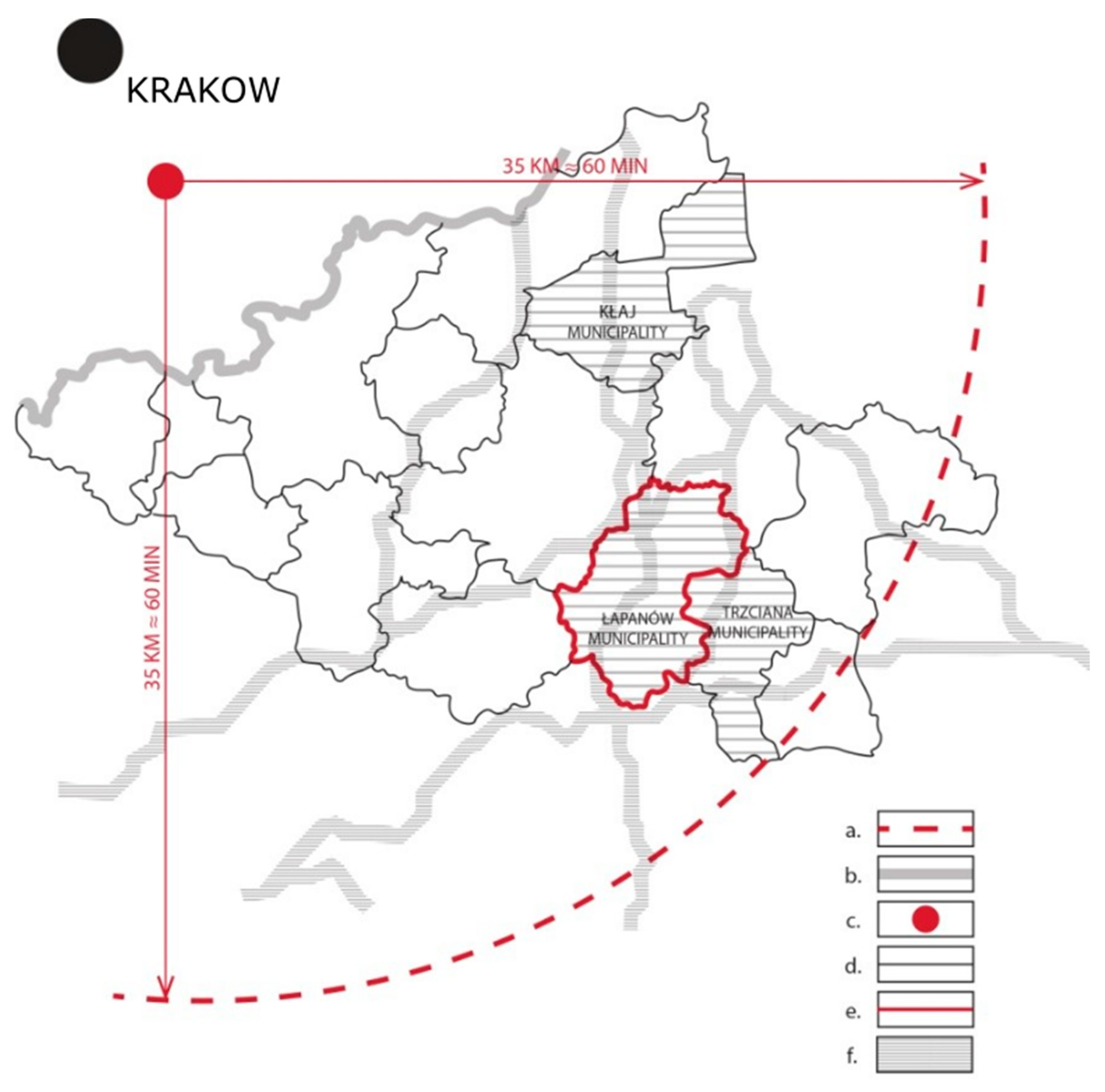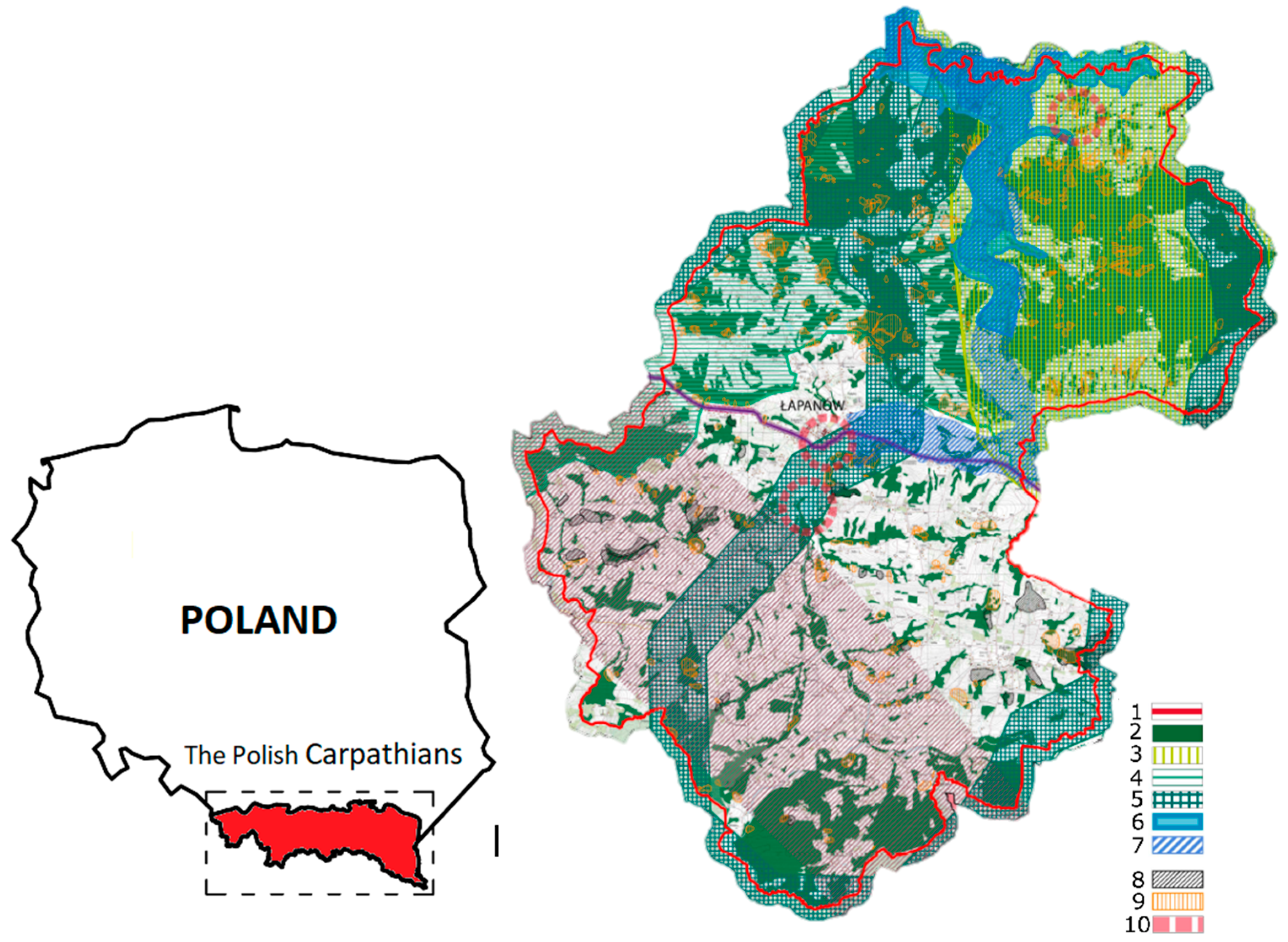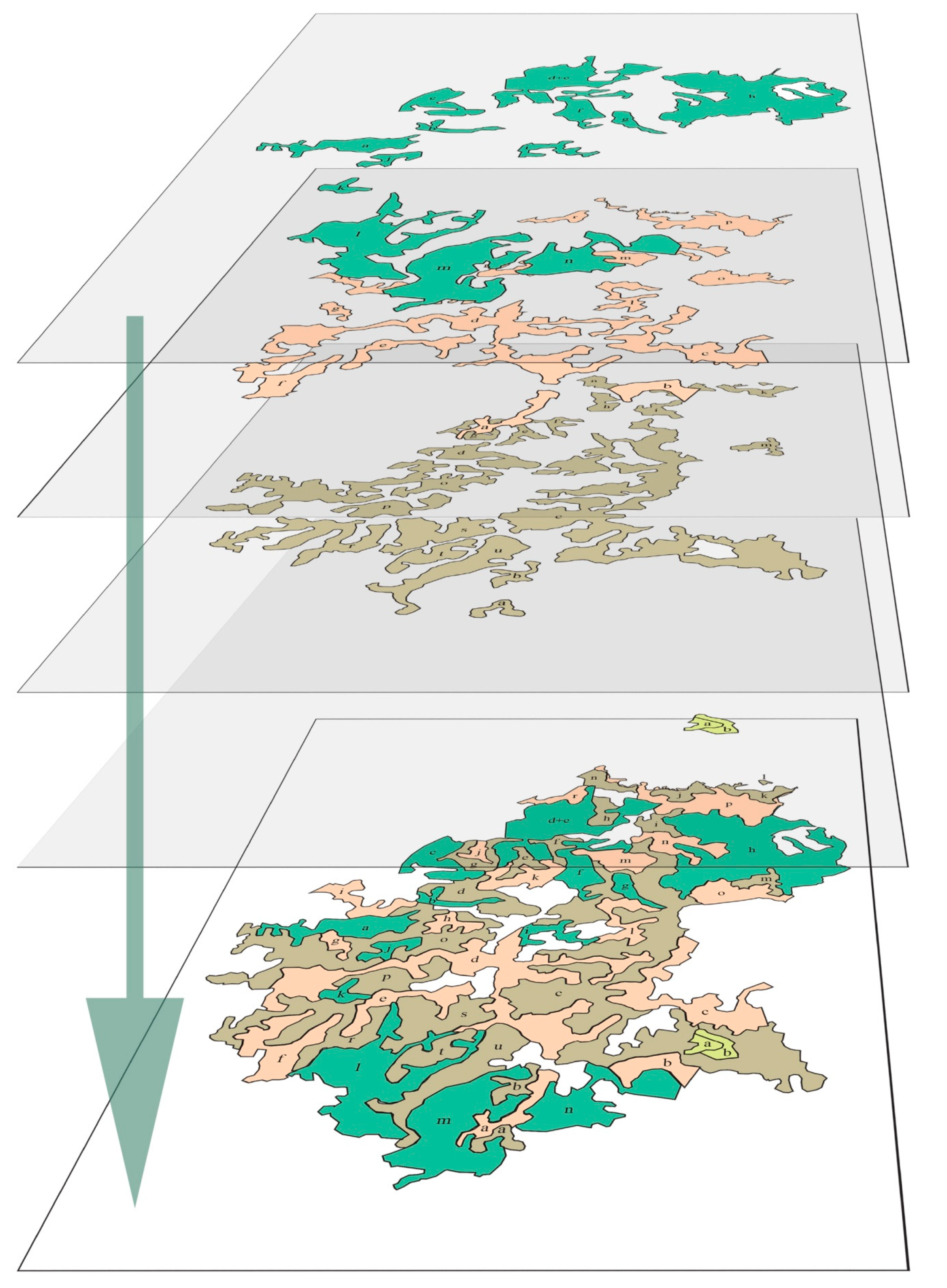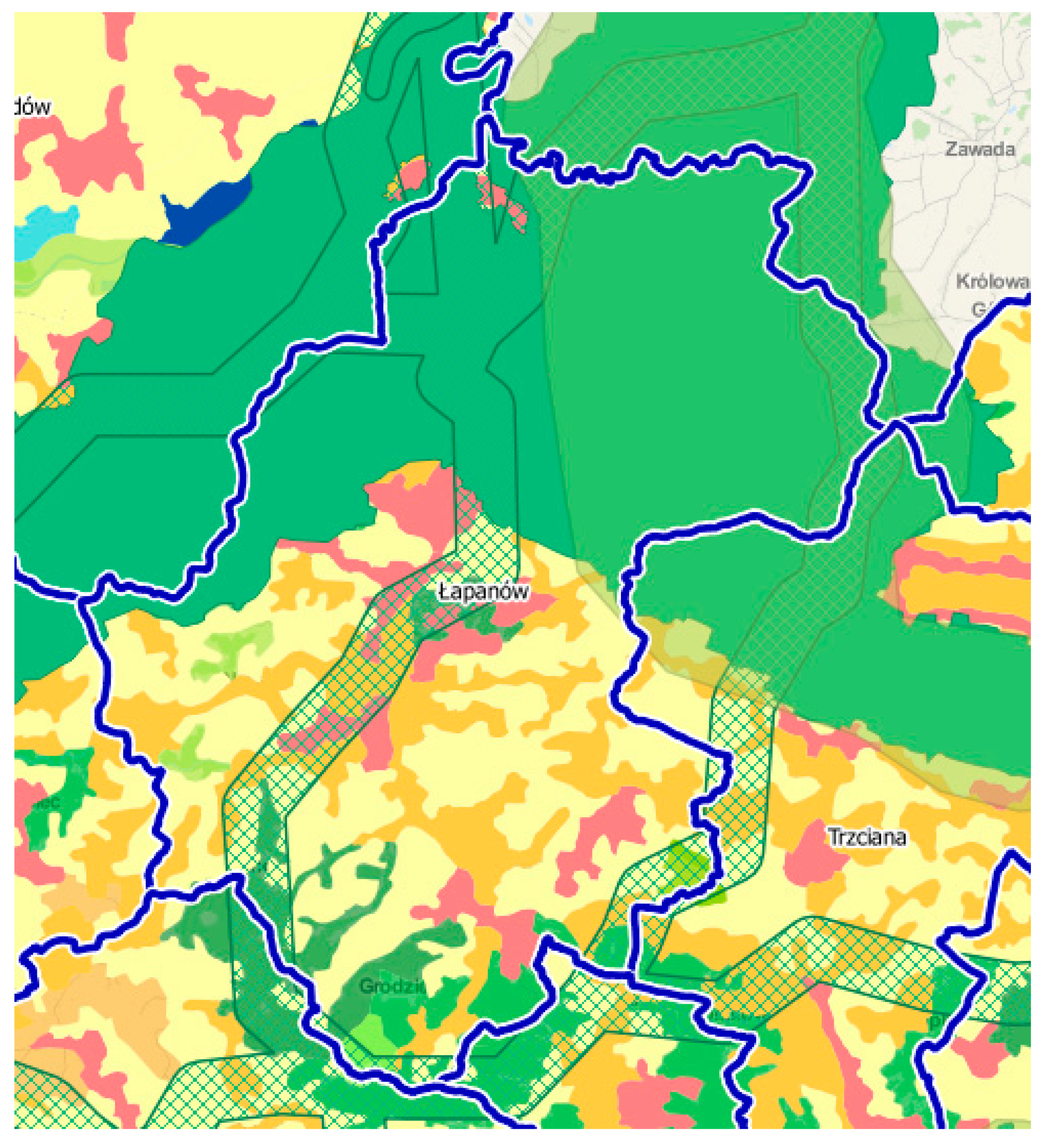Green Infrastructure—Countering Ecosystem Fragmentation: Case Study of a Municipality in the Carpathian Foothills
Abstract
1. Introduction
2. Materials and Methods
2.1. Beginnings of Green Infrastructure
- Tree planting;
- Decoupling non-permeable areas;
- Building green roofs;
- Using semipermeable porous surfaces;
- Creating infiltration pools; chambers and ditches;
- Creating plant baths
- Practicing bioretention;
- Use of rain gardens.
- Natural and cultural heritage that constitutes a part of the EU’s capital and identity;
- Utilizing soil potential instead of air-conditioning—financial savings;
- Alleviating climate change consequences and adaptation to them;
- Building resilience and improving defensive mechanisms against flooding;
- Sustainable agricultural land management;
- Prevention of soil erosion;
- Harmonizing human activities with the natural environment.
2.2. What Is Green Infrastructure Now?
2.3. Green Infrastructure—Significance of Protecting the Natural Environment in the Carpathian Mountains
2.4. Łapanów: Case Study-Cultural and Ecological Heritage
2.5. Natural Capital Assessment: Comparative Table with Municipalities of the Carpathian Foothills
2.6. Analysis of Planning Documents in Terms of green infrastructure Provisions
2.7. Average Green Infrastructure Fragmentation Coefficient for the Area under Study
3. Results
Calculation of the Average Green Infrastructure Fragmentation Coefficient for the Territory of Łapanów
4. Discussion
5. Conclusions
Supplementary Materials
Author Contributions
Funding
Acknowledgments
Conflicts of Interest
References
- European Commission. Communication from the Commision to the European Parliament, The Council, The European Economic and Social Comittee and the Committee of the Regions. Green Infrastructure (GI)—Enhancing Europe’s Natural Capital; (COM (2013) 249 final); European Commission: Luxembourg, 2013. [Google Scholar]
- Sandström, U.G. Green infrastructure planning in urban Sweden. Plan. Pract. Res. 2002, 17, 373–385. [Google Scholar] [CrossRef]
- Schilling, J.; Logan, J. Greening the rust belt: A green infrastructure model for right sizing America’s shrinking cities. J. Am. Plan. Assoc. 2008, 74, 451–466. [Google Scholar] [CrossRef]
- Riitters, K.; Wickham, J.; Vogelmann, J.; Jones, K. National Land-Cover Pattern Data. Ecology 2000, 81, 604. [Google Scholar] [CrossRef]
- Laurance, W.F. Predicting the Impacts of Edge Effects in Fragmented Habitats. Biol. Conserv. 1991, 55, 77–92. [Google Scholar] [CrossRef]
- Thiele, J.; Schuckert, U.; Otte, A. Cultural landscapes of Germany are patch-corridor-matrix mosaics for an invasive megaforb. Landsc. Ecol. 2008, 23, 453–465. [Google Scholar] [CrossRef]
- Tzoulas, K.; Korpela, K.; Venn, S.; Yli-Pelkonen, V.; Kaźmierczak, A.; Niemela, J.; James, P. Promoting ecosystem and human health in urban areas using Green Infrastructure: A literature review. Landsc. Urban Plan. 2007, 81, 167–178. [Google Scholar] [CrossRef]
- Ahern, J. Green Infrastructure for Cities The Spatial Dimension. Available online: https://www.semanticscholar.org/paper/Green-Infrastructure-For-Cities-The-Spatial-Ahern/5a5eaa2f3394bf3c8e5eb4400812b2d3c822eb9d (accessed on 27 November 2020).
- Firehock, K. A Short History of the Term Green Infrastructure and Selected Literature. Available online: http://www.gicinc.org/PDFs/GI%20History.pdf (accessed on 27 November 2020).
- Da Silva, J.M.C.; Wheeler, E. Ecosystems as infrastructure. Perspect. Ecol. Conserv. 2017, 15, 32–35. [Google Scholar] [CrossRef]
- Benedict, M.A.; McMahon, E.T. Green Infrastructure: Smart Conservation for the 21st Century. Renew. Res. J. 2002, 20, 12–17. [Google Scholar]
- The President’s Council on Sustainable Development. Towards a Sustainable America—Advancing Prosperity, Opportunity, and a Healthy Environment for the 21st Century; The President’s Council on Sustainable Development: Washington, DC, USA, 1999. [Google Scholar]
- European Commission. Regulation of the European Parliament and The Council on the Cohesion Fund and repealing Council Regulation (EC) No 1084/2006; (COM (2011) 612 final/2); European Commission: Luxembourg, 2012. [Google Scholar]
- European Commission. Regulation of the European Parliament and of the Council on specific Provisions Concerning the European Regional Development Fund and the Investment for Growth and Jobs Goal and Repealing Regulation (EC) No 1080/2006; (COM (2011) 614 final); European Commission: Luxembourg, 2011. [Google Scholar]
- United Nations. United Nations Framework Convention on Climate Change; United Nations: New York, NY, USA, 1992. [Google Scholar]
- Slätmo, E.; Nilsson, K.; Turunen, E. Implementing Green Infrastructure in Spatial Planning in Europe. Land 2019, 8, 62. [Google Scholar] [CrossRef]
- Weber, T.; Wolf, J. Maryland’s Green Infrastructure—Using Landscape Assessment Tools to Identify a Regional Conservation Strategy. Environ. Monit. Assess. 2000, 63, 265–277. [Google Scholar] [CrossRef]
- Benedict, M.A.; McMahon, E.T. Green Infrastructure Linking Landscapes and Communities. In The Conservation Fund; Island Press: Washington, DC, USA, 2006; ISBN 1-59726-027-4. [Google Scholar]
- Mell, I.C. Green infrastructure: Concepts, Perceptions and Its Use in Spatial Planning. Ph.D. Thesis, School of Architecture, Planning and Landscape Newcastle University, Newcastle, UK, 2010. [Google Scholar]
- Dennis, M.; Barlow, D.; Cavan, G.; Cook, P.A.; Gilchrist, A.; Handley, J.; James, P.; Thompson, J.; Tzoulas, K.; Wheater, C.P.; et al. Mapping Urban Green Infrastructure: A Novel Landscape-Based Approach to Incorporating Land Use and Land Cover in the Mapping of Human-Dominated Systems. Land 2018, 7, 17. [Google Scholar] [CrossRef]
- Panagopoulos, T. Special Issue: Landscape Urbanism and Green Infrastructure. Land 2019, 8, 112. [Google Scholar] [CrossRef]
- Snäll, T.; Lehtomäki, J.; Arponen, A.; Elith, J.; Moilanen, A. Green Infrastructure Design Based on Spatial Conservation Prioritization and Modeling of Biodiversity Features and Ecosystem Services. Environ. Manag. 2016, 57, 251–256. [Google Scholar] [CrossRef] [PubMed]
- Carpathian Convention. Framework Convention on the Protection and Sustainable Development of the Carpathians; Carpathian Convention: Kyiv, Ukraine, 2003. [Google Scholar]
- Hrehorowicz-Gaber, H. Contemporary Changes and Development of Spatial Structures in the Carpathians: Conditions and Development Models; Cracow University of Technology: Cracow, Poland, 2019. [Google Scholar]
- Lapanow Municipal Council. Uchwała Nr VII/44/03 Rady Gminy Łapanów z dnia 4 lipca 2003 r. w Sprawie: Uchwalenia “Miejscowego Planu Zagospodarowania Przestrzennego Gminy Łapanów”; Lapanow Municipal Council: Lapanow, Poland, 2003. [Google Scholar]
- Forman, R.T.T.; Godron, M. Landscape Ecology; Wiley: New York, NY, USA, 1986; ISBN 978-0-471-87037-1. [Google Scholar]
- Vogt, P.; Riitters, K.H.; Estreguil, C.; Kozak, J.; Wade, T.G.; Wickham, J.D. Mapping Spatial Patterns with Morphological Image Processing. Landsc. Ecol. 2007, 22, 171–177. [Google Scholar] [CrossRef]
- Fahrig, L. Effects of Habitat Fragmentation on Biodiversity. Annu. Rev. Ecol. Evol. Syst. 2003, 34, 487–515. [Google Scholar] [CrossRef]
- Wintle, B.A.; Kujala, H.; Whitehead, A.; Cameron, A.; Veloz, S.; Kukkala, A.; Moilanen, A.; Gordon, A.; Lentini, P.E.; Cadenhead, N.C.R.; et al. Global synthesis of conservation studies reveals the importance of small habitat patches for biodiversity. Proc. Natl. Acad. Sci. USA 2019, 116, 909–914. [Google Scholar] [CrossRef]
- Blazy, R. Living Environment Quality Determinants, Including PM2.5 and PM10 Dust Pollution in the Context of Spatial Issues—The Case of Radzionków. Buildings 2020, 10, 58. [Google Scholar] [CrossRef]
- Valdés, A.; Lenoir, J.; Frenne, P.D.; Andrieu, E.; Brunet, J.; Chabrerie, O.; Cousins, S.A.O.; Deconchat, M.; Smedt, P.D.; Diekmann, M.; et al. High ecosystem service delivery potential of small woodlands in agricultural landscapes. J. Appl. Ecol. 2020, 57, 4–16. [Google Scholar] [CrossRef]
- Mikołajczyk, P.; Szewczyk, M.; Andrzejewska, M.; Rusztecka, M.; Jabłońska, B.; Starczewski, D. Mapowanie i Ocena Ekosystemów i ich Usług w Polsce; GRID: Warsaw, Poland, 2015. [Google Scholar]
- Carpathians Unite—Green Infrastructure. Available online: https://mapa.karpatylacza.pl/GreenGO-Carpathians (accessed on 27 November 2020).
- Maciantowicz, M. Fragmentacja kompleksów leśnych jako istotne zagrożenie cywilizacyjne. Stud. Mater. Cent. Eduk. Przyr. Leśnej Rogowie 2018, 20, 40–49. [Google Scholar]
- MacArthur, R.H.; Wilson, E.O. The Theory of Island Biogeography; Princeton University Press: Princeton, NJ, USA, 2001; ISBN 978-0-691-08836-5. [Google Scholar]
- Frankel, O.; Soulé, M.E. Conservation and Evolution; Cambridge University Press: Cambridge, UK, 1981; ISBN 978-0-521-29889-6. [Google Scholar]
- Soulé, M.E. Viable Populations for Conservation; Cambridge University Press: Cambridge, UK, 1987; ISBN 978-0-521-33657-4. [Google Scholar]
- Giulio, M.D.; Holderegger, R.; Tobias, S. Effects of habitat and landscape fragmentation on humans and biodiversity in densely populated landscapes. J. Environ. Manag. 2009, 90, 2959–2968. [Google Scholar] [CrossRef]
- Eisenman, T.S. Frederick Law Olmsted, Green Infrastructure, and the Evolving City. J. Plan. Hist. 2013, 12, 287–311. [Google Scholar] [CrossRef]
- Choiński, A.; Borkowski, G. Waloryzacja jezior dla potrzeb turystyki i wypoczynku. In Uwarunkowania i Plany Rozwoju Turystyki; Wydawnictwo Naukowe UAM: Poznań, Poland, 2008; Volume I—Przyrodnicze Zasoby Turystyczne i Metody ich Oceny, pp. 35–58. [Google Scholar]
- Frankham, R.; Bradshaw, C.J.A.; Brook, B.W. Genetics in conservation management: Revised recommendations for the 50/500 rules, Red List criteria and population viability analyses. Biol. Conserv. 2014, 170, 56–63. [Google Scholar] [CrossRef]
- Manton, M.; Angelstam, P. Defining Benchmarks for Restoration of Green Infrastructure: A Case Study Combining the Historical Range of Variability of Habitat and Species’ Requirements. Sustainability 2018, 10, 326. [Google Scholar] [CrossRef]
- Verburg, P.H.; Schot, P.P.; Dijst, M.J.; Veldkamp, A. Land use change modelling: Current practice and research priorities. GeoJournal 2004, 61, 309–324. [Google Scholar] [CrossRef]
- Wang, J.; Pauleit, S.; Banzhaf, E. An Integrated Indicator Framework for the Assessment of Multifunctional Green Infrastructure—Exemplified in a European City. Remote Sens. 2019, 11, 1869. [Google Scholar] [CrossRef]
- Davies, C.; Macfarlane, R.; Mcgloin, C.; Roe, M. Green Infrastructure Planning Guide Authors; Northumbria University: Newcastle, UK, 2015. [Google Scholar]
- Niedźwiecka-Filipiak, I.; Rubaszek, J.; Potyrała, J.; Filipiak, P. The Method of Planning Green Infrastructure System with the Use of Landscape-Functional Units (Method LaFU) and its Implementation in the Wrocław Functional Area (Poland). Sustainability 2019, 11, 394. [Google Scholar] [CrossRef]
- Yacamán Ochoa, C.; Ferrer Jiménez, D.; Mata Olmo, R. Green Infrastructure Planning in Metropolitan Regions to Improve the Connectivity of Agricultural Landscapes and Food Security. Land 2020, 9, 414. [Google Scholar] [CrossRef]
- Ministry of Construction, Spatial and Housing Economy; The Council Of Ministers. Act on Spatial Planning and Development. J. Laws U. 2003, 80, 717. [Google Scholar]





| Initiative | Number of Signatories | Major Signatories |
|---|---|---|
| Global Reporting Initiative | Over 960 organizations | ABN AMRO, HSBC, Citigroup, Barclays |
| UNEP Finance Initiative | 176 institutions | Bank of America, Credit Suisse Group, JPMorgan Chase and Co. |
| UN Principles for Responsible Investment | Over 850 organizations | CalPERS, ABP, Swiss Re, etc. |
| UN Global Compact | 8700 organizations (6500 organizations and business associations and 2200 nonprofits) | Deutche Bank, ING Group, Mitsubishi, UFJ |
| The Equator Principles | 67 | Citigroup, ABN AMRO, Barclays, WestLB |
| Carbon Disclosure Project | 534 Fls holding, US$64 trillion in assets, 60 purchasing organizations 3000 organizations in about 60 countries | Goldman Sachs, Morgan Stanley, CalPERS, Cadbury, PepsiCo, Walmart |
| Institutional Investors’ Group on Climate Change | Over 20 UN agencies | The Bretton Woods Institutions, an issue management group (IMG) on green economy |
| UN Secretary-General’s High-Level Advisory Group on Climate Change Financing | Three heads of state and 10 high office holders and public and private sector leaders | N/A |
| Municipalities Selected for Comparison | Cultural Infrastructure | Tourism Infrastructure | Essential Green Infrastructure Elements | ||
|---|---|---|---|---|---|
| Municipality | Significant Tangible Heritage | Accommodations/Gastronomy | Agricultural Landscape/Disappearance | Forest Cover (District Average/Municipality) | Open Waters Used for Recreation |
| Łapanów | ● | ● | ● | 28.4/26.6 | ● |
| Trzciana | ○ | ○ | ● | 28.4/23.9 | ○ |
| Gdów | ○ | ● | ●/○ | 15.6/9.8 | ● |
| Biskupice | ○ | ○ | ●/○ | 15.6/8.6 | ○ |
| Kłaj | ○ | ○ | ● | 15.6/44.6 | ● |
| Mogilany | ● | ● | ●/○ | 12.3/13.0 | ○ |
| Świątniki Górne | ○ | ● | ●/○ | 12.3/13.9 | ○ |
| Local Spatial Development Plan Provision | Beneficial to GI | Notes |
|---|---|---|
| Assignation of class III (max 0.5 ha), IV (max 1 ha) and VI farmland to non-agricultural use | ✕ | No conditions of land-use change that would compensate for GI loss |
| Protection of acoustic climate in single-family housing areas, single-family housing and tourist accommodation areas, single-family housing and service areas | ✓ | Allows for creating minor enclaves of greenery—less severe edge effect |
| Prohibition on activity that is a nuisance to the environment, which threatens water management infrastructure and natural surface and underground water resources | ✓ | Blue infrastructure—no definition of nuisance. Applies only to water—no provisions concerning animal habitats |
| Building footprint/plot area ratio (MN) | ✓ | Max 40% |
| Biologically active area/plot area ratio (MN) | ✓ | Min 40% |
| Prohibition on wastewater disposal and economic activity that could worsen natural conditions in the Stradomka River Valley | ✓ | |
| Prohibition activity that can lead to large-scale pollution in areas of the conservation of the “Dolina Stradomki”’ Main Underground Water Reservoir GZWP no. 442 and IBŁ reservoir (Iwkowa–Bochnia–Lapanów) | ✓ | |
| Building footprint/plot area ratio—max 80% Biologically active area/plot area ratio—min. 10% With a possibility of adjusting these indicators to local conditions in Łapanów—in street frontages or along the voivodeship road along the northern edge of the market square and in Grab at site Z23.MN.U. | ✕ | Possibility of adaptation to local conditions—possibly exploitable |
| Enhancement with landscaped greenery—tall or low, in Łapanów | ✓ | No indications of whether domestic species are preferred or not |
| Roofing should be made of roof tiles, metal sheets or wooden shingles | ✓ | No green roofs allowed—benefit or hindrance? |
| Natural greenery—including forest greenery and tree stands—should be protected when developing land covered by the plan. | ✓ | |
| New plantings should maintain the greenery’s natural character—adapted to the location and function of buildings. | ✓ | Natural character of greenery—does not explicitly state a preference for domestic species or design (lawns) |
| Plot front width should be at least 16 m for detached single-family houses | ✓ | Fragmentation prevention, preservation of green spaces |
| Priority functio-spatial regions—area of agriculture and area of recreation, for which the provisions are intended to preserve cultural and landscape assets of the municipality’s territory and protection against introducing grouped manufacturing functions into housing and service areas. Agriculture priority area and recreation priority area | ✓ | |
| Areas with restrictions and environmental protection provisions | ✓ | |
| Incorporation of the Municipality’s territory into the ecological network via the Wiśnicz Foothills Protected Landscape Region | ✓ | |
| Agriculture is to be the temporary form of land-use in areas for development | ✕ | |
| Protection of high-quality class soils from development | ✓ | Are projects like parks also prohibited? |
| Protection of agricultural areas of exceptional landscape value | ✓ | No mention of paths, the mosaic-like character of agricultural areas, no specifics as to what areas of exceptional landscape values are |
| Melioration, particularly of permanent green land-use (due to poor soil moisture) | ✕ | |
| Transformation of agricultural land-use into meadows and pastures | ✓ | |
| Zone of unconditional protection against development in forested areas and the immediate biological buffer zone of rivers and creeks | ✓ | |
| Prohibition on any activity that threatens existing forest resources | ✓ | |
| Delineation of functional zones with adaptation of development or no such option | ✓ | |
| Modernization of farms, development of farming production and service centers | ✓/✕ | No conditions that would compensate for any environmental losses incurred |
| Efforts to recognize all forest patches in the municipality as protective forests | ✓ | No definition of the types and percentage composition of different types of protective forests (recreational, geo-protective, climatic, etc.) |
| Execution of afforestation programs in existing forest areas and afforestation of existing agricultural production areas of the lowest value. | ✓ |
| Voivodeship | Total Developed Area to Plot Ratio in the Voivodeship | Loose Development (%) | Compact Development (%) |
|---|---|---|---|
| Lesser Poland | 18.50 | 18.90 | 81.10 |
| Subcarpathian | 10.62 | 18.56 | 81.44 |
| Silesian | 20.90 | 10.12 | 89.88 |
| Ecosystem | Sum of an Ecosystem’s Elements’ (Patches’) Fragmentation Coefficients | Number of Elements (Patches) of a Given Ecosystem | Average K1 + K2 Coefficient Value |
|---|---|---|---|
| Grassy and scrub | 8.39 | 1 | 8.39 |
| Forest and tree-based | 135.87 | 13 | 10.45 |
| Mosaic-type farmland | 173.38 | 16 | 10.84 |
| Large-scale farmland | 194.57 | 19 | 10.24 |
| Sum total | 39.92 | ||
| Average green infrastructure fragmentation coefficient for the municipality’s territory | 39.92:4 | 9.98 | |
Publisher’s Note: MDPI stays neutral with regard to jurisdictional claims in published maps and institutional affiliations. |
© 2021 by the authors. Licensee MDPI, Basel, Switzerland. This article is an open access article distributed under the terms and conditions of the Creative Commons Attribution (CC BY) license (http://creativecommons.org/licenses/by/4.0/).
Share and Cite
Rafał, B.; Hanna, H.-G.; Alicja, H.-N. Green Infrastructure—Countering Ecosystem Fragmentation: Case Study of a Municipality in the Carpathian Foothills. Forests 2021, 12, 78. https://doi.org/10.3390/f12010078
Rafał B, Hanna H-G, Alicja H-N. Green Infrastructure—Countering Ecosystem Fragmentation: Case Study of a Municipality in the Carpathian Foothills. Forests. 2021; 12(1):78. https://doi.org/10.3390/f12010078
Chicago/Turabian StyleRafał, Blazy, Hrehorowicz-Gaber Hanna, and Hrehorowicz-Nowak Alicja. 2021. "Green Infrastructure—Countering Ecosystem Fragmentation: Case Study of a Municipality in the Carpathian Foothills" Forests 12, no. 1: 78. https://doi.org/10.3390/f12010078
APA StyleRafał, B., Hanna, H.-G., & Alicja, H.-N. (2021). Green Infrastructure—Countering Ecosystem Fragmentation: Case Study of a Municipality in the Carpathian Foothills. Forests, 12(1), 78. https://doi.org/10.3390/f12010078





